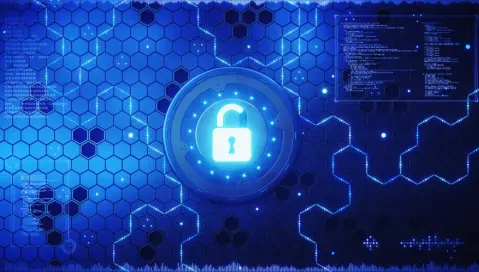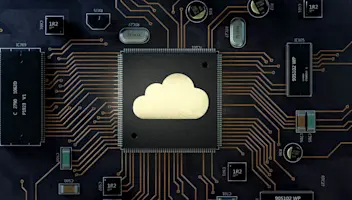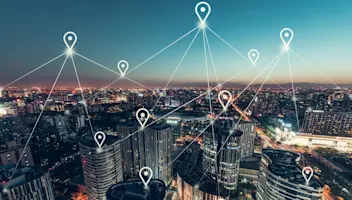Uitgelicht in deze blog
The Rising Threat of Ransomware Attacks: Leveraging Cloud Technology for Ransomware Protection
The Rising Threat of Ransomware Attacks: Leveraging Cloud Technology for Ransomware Protection
10 Aug 2023
Aptean Staff Writer
Ransomware is destructive and malicious software that will hold your data hostage. Cybercriminals use it to threaten their victims with access restrictions or public release of confidential information if they do not pay the ransom fee.
It's a significant challenge for businesses today. In 2022, over 493 million ransomware attacks were detected by organizations worldwide. The average cost of ransomware attacks is $4.54 million for businesses.
According to a Dragos study, the manufacturing industry accounted for 65% of ransomware incidents in 2022. The top three manufacturing subsectors that suffered the most attacks were fabricated metals, automotive and plastic/technology. Manufacturers were targeted six times as often compared to the second-leading ransomware target—food and beverage companies.
Moreover, an estimated 30,000 websites are hacked every day, and experts said that ransomware attacks happen every 11 seconds. In the U.S., all 50 states—including all U.S. territories—have security breach notification laws that require businesses to notify consumers if they experience data breaches. Similarly, in the European Union, GDPR legislation (specifically Article 33) dictates that organizations must report a breach that affects personal data to a Data Protection Authority (DPA) within 72 hours.
Ransomware attackers often target on-premise systems since it's much easier to infiltrate their security measures compared to those of cloud-based systems. That means that migrating to the cloud may help you protect your organization’s resources from ransomware attacks.
Let’s explore how cloud-based solutions help prevent unauthorized access and the planting of suspicious files while also enabling quarantining and recovery of affected data in your system.
Alarming Ransomware Attacks
Even big companies and governments with the best anti-virus scanning software may be infiltrated by undetected ransomware files. Here are some examples of recent ransomware attacks that may surprise you:
Ransomware Attack on Intel
In March 2023, the Money Message extortion gang claimed to have stolen over 1.5 TB of firmware, source code and databases from tech giant Intel. These cyber criminals demanded $4 million in ransom and threatened to leak the confidential data if not paid in their given time.
A couple of months after the threat, these cyber extortionists began leaking MSI's data, including the firmware source code used in MSI's motherboards. It's said to have the image signing private keys for 57 MSI products and Intel Boot Guard private keys for 116 MSI products.
KFI Engineers Pays $300K to Ransomware Criminals
In February 2023, KFI Engineers paid $300,000, half of what the Black Basta ransomware group initially demanded.
KFI counts process manufacturing businesses; packaged food and beverage manufacturers; hospitals; and schools among its main clients. On Black Basta’s ransom note, they claimed to have stolen 1.1 TB of sensitive data of patients and students.
Ransomware Attack on Canadian Grocery Chain Costs $25M
Sobey’s, a major grocery store chain in Canada, was hit by a ransomware attack. It dragged down their annual net earnings by around $25 million.
The ransomware attack caused turmoil in their inventory system, and some stores ran out of essential items like food and other perishable goods. Moreover, their pharmacies were shut down for four days leaving their customers struggling to purchase prescription medicines.
The Rise of Ransomware Attacks on Businesses in Numbers
Cybersecurity Ventures predicts that ransomware attacks will exceed $30 billion by the end of 2023 and $265 billion annually by 2031. They also expect that attacks will be reported every two seconds by that time. In fact, they report that in 2022 around 73% of all business organizations suffered ransomware attacks.
Moreover, the cost of data breaches in the government sector averages $2 million, and the average ransom demand of cybercriminals is around $1.5 million. Surprisingly, approximately 80% of the companies that chose to pay the price will most likely be attacked again.
Understanding the Methods of Ransomware Attacks
Ransomware criminals always aim at two inevitable vulnerabilities—humans and systems. The attacks will likely start with an email that looks harmless. If your workforce isn’t cautious, they may click through these emails without verification. The moment someone accidentally opens these phishing emails, your organization is at risk.
There are other types of cyberattacks, but these are the most common ransomware methods:
Encryption ransomware - This is the most rampant method. It allows the attackers to encrypt your data using malware to make it inaccessible and then demand ransom payment for the decryption key.
Locker ransomware - This method completely locks you out of your system. Usually, your screen will display the hackers' demands with a countdown clock for urgency.
Scareware tactics - These take the form of fake software that will warn you about the potential risk to your computer. More advanced types will lock your computer or flood you with pop-up alerts about possible malware. It will only stop once you pay the attackers’ demands.
Leak scares - With this strategy, attackers will threaten to distribute your confidential information online. Most victims will most likely pay the ransom to prevent sensitive information from leaking to the public eye.
Ransomware-as-a-Service (RaaS) - Sad to say, but some professional hackers host malware as a service. They will handle the plans for the attack and its implementation. In return, they will receive a cut of the ransom fee.
average cost of a ransomware attack for the targeted business
Consequences and Risk of Falling Victim to a Ransomware Attack
Anyone can become a target of ransomware. Businesses have permanently lost sensitive or proprietary information and experienced disruption to their operations—not to mention the considerable loss of money and time. Furthermore, ransomware attacks affect their reputation, and public distrust may result in the loss of future revenue opportunities. In a study by Northwave Security, ransomware attacks may also cause long-term mental stress to their victims. Below are the major risks if you fall victim to a ransomware attack:
Operational Loss/Impact
The operational impact of a ransomware attack goes beyond the expenses and lost opportunities. It also brings decreased productivity, order fulfillment delays, outages, production downtime, low morale for your workforce and distrust from your clients.
Financial Loss
Part of the aftermath of a ransomware attack is financial loss. We're not even talking about the ransom demands—the more severe burden of a ransomware attack is on your revenue, including the cost of downtime and wasted labor, not to mention missed earning opportunities.
Damaged Brand Reputation
Building a strong brand reputation for your organization takes time and resources. A ransomware attack has the potential to instantly ruin everything you've created. It can compromise the trust between you and your customers. It can make your clients lose confidence and feel betrayed if their data is compromised. Moreover, you can reduce brand value with unfavorable public perception, as ransomware attacks often receive media coverage.
Loss of Confidential Data
Data loss is one of the most frightening aspects of a ransomware attack. In this data-driven business landscape, confidential data is valuable to every organization. The data recovery process will take time without the assurance that you'll retrieve all you've lost. Moreover, the loss of customer data has some legal repercussions.
Legal Implications Due to Data Breaches
If you’re a ransomware victim, you may need to prepare for upcoming lawsuits. Civil liability following a ransomware attack may incur monetary compensation for your clients and customers, and the average remediation cost is $200,000.
Moreover, in the U.S. the Federal Trade Commission Act protects consumers against organizations that fail to comply with privacy policies and data disclosure, often resulting in millions of dollars in fines.
The Role of Cloud Technology in Mitigating Ransomware Risks
Migrating your business management technologies to the cloud can be an effective way to protect your data against ransomware attacks. Cloud-based systems automatically scan suspicious and recent modifications to files as ransomware protection. It will notify your IT teams immediately and offer an automated check on activity logs with related IP addresses.
In what other ways can a cloud-based system strengthen your cybersecurity? Here are some cloud benefits and how each can help protect you against ransomware attacks:
Improved data security and encryption - Cloud encryption offers end-to-end protection of data stored on the platform, across devices and between users.
Robust backup and disaster recovery functions - Cloud backup and recovery features help ensure business continuity. The solution regularly transmits your data over a secured cloud-based server.
Enhanced threat detection and prevention mechanisms - Cloud security features can find and confirm malicious activities and automatically respond to mitigate threats or report them to your IT team.
Isolation and sandboxing features for suspicious activities - The cloud sandbox provides a safe environment that categorizes files as "safe" or "unsafe.” It may help protect your network by preventing new files from entering your system before they are tested in the safe environment.
Scalable infrastructure and resources for added defense - Scalability is one of the best aspects of the cloud. You can increase or decrease your IT resources depending on your security requirements. Scalable infrastructure can also optimize disaster recovery without maintaining secondary data facilities.
Access controls and identity management - In the cloud, you can initiate, record and manage user identities and access permissions based on staff roles.
Redundancy and data availability - Data redundancy in the cloud means that information is replicated in two or more secured servers, meaning it's always protected in case of a failure at one site.
Best Practices for Increasing Your Cloud Security Against Ransomware
Implementing a Multi-Layered Security Approach
Multi-layered security implementation is the process of using a variety of security measures to protect your data. Cybercriminals must infiltrate the physical, administrative and technical security measures before they can access your system.
Regular Data Backups and Tests of Recovery Procedures
Scheduling regular backup and recovery testing is an important part of a disaster recovery (DR) plan. It can help you gauge your security program's effectiveness in replicating data and retrieving it if needed.
Employee Training and Awareness Programs
Recent research found that human vulnerability is the leading cause—over 90%—of security breaches and ransomware attacks. Hence, regular employee training and security awareness programs can minimize the possibility of becoming a ransomware victim.
Real-Time Monitoring and Well-Planned Incident Response
Once cybercriminals have broken into your system, the initial phases of the attack are likely to last for days or weeks, and the last stage can happen when you least expect it. Real-time monitoring of your network endpoints and a well-planned incident response empower your IT team and help mitigate or lessen the ransomware's damage.
of businesses suffered a ransomware attack in 2022
Working with Reputable Cloud-Based Solution Providers
Ransomware is a global threat to all organizations, whether in business, governments or individual entities. An attack can severely affect your daily operations, cost millions of dollars and jeopardize your brand reputation.
Many businesses are making the move to cloud-based software to mitigate ransomware risks and secure their data. The security features of a cloud-based solution can help safeguard your confidential resources against ransomware attacks.
Indeed, reputable cloud-based solution providers have the expertise and infrastructure that helps protect your data and resources from ransomware attacks. The best providers have 24/7 customer service to ensure all your cloud-based applications work seamlessly and cybersecurity capabilities that are best-in-class.
As the manufacturing industry becomes a primary target of ransomware criminals, you may want to migrate your core on-premise ERP business systems to a cloud-based enterprise resource planning (ERP) platform that provides increased reliability, security and accessibility of your business processes and data.
Partner with Aptean and Leverage Our Cloud-Based Solutions to Fight Against Ransomware
Aptean offers cloud-based ERP solutions developed for the food and beverage, fashion and apparel, industrial manufacturing, process manufacturing, equipment and import and distribution industries. Moreover, we were recently recognized in the top 10% of companies in The Software Report's Power 500 Software Companies of 2023. Aptean earned the 30th overall spot on the list, putting us in the upper echelon and standing as a testament to the performance of our systems.
Discover more cloud-based purpose-built solutions that can help your business scale and grow. Book a personalized demo with an Aptean subject matter expert today.
Related Content


Klaar om uw bedrijf naar een hoger niveau te tillen?
We hebben de gespecialiseerde software om uw organisatie verder te helpen.






